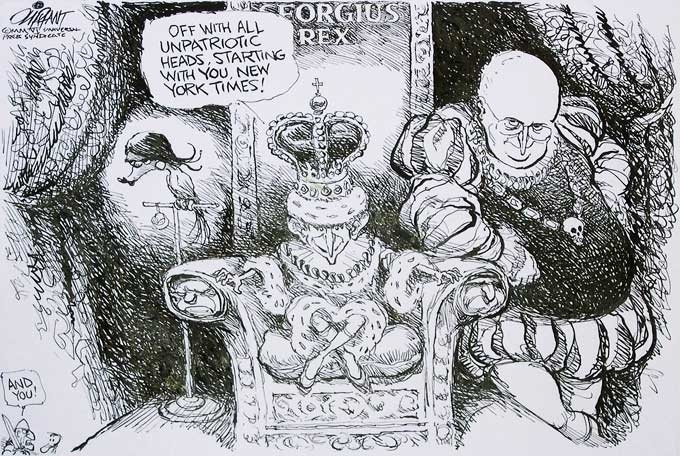Oliphant: Editorial Cartoons and the American Presidency, 1968–2012
–
On the occasion of this year’s national presidential election the Middlebury College Museum of Art has mounted an exhibit of twenty political cartoons—and one bronze sculpture—created by the noted political cartoonist Patrick Bruce “Pat” Oliphant (b.1935). Oliphant: Editorial Cartoons and the American Presidency, 1968–2012 features ten caricatures, acquired by the museum in 2010 and never previously exhibited, which provide historical insight into issues that preoccupied Americans during the thirty-sixth through forty-third presidencies—i.e., from Lyndon B. Johnson to George W. Bush—as well as ten caricatures pertaining to the current election which are on loan from the artist himself.

Patrick Bruce Oliphant (American, born Australia, b. 1935), Georgius Rex, 2006, pen and ink on paper, 11 x 14 inches. Collection of Middlebury College Museum of Art, Vermont. Purchase with funds provided by the Walter Cerf Art Fund, 2010.009
Political cartoons have been part of the American landscape since the eighteenth century and, as a consequence, prominent figures in the public sphere have been considered fair game for rebuke. Such activity reached new heights in the nineteenth century with the advent of lithography, which reduced printing costs and permitted large print runs. Particularly notable caricatures began to appear with the presidency of Andrew Jackson and increased steadily during the years leading up to the Civil War.
Prior to the modern era, the greatest surge in political caricatures appeared during the 1860 presidential campaign and the presidency of Abraham Lincoln. The national issues of secession, abolition of slavery, and the possibility of war gave an unprecedented urgency to the national discussions in which caricatures of political leaders were intended to reflect and influence public opinion.
A native of Australia, Oliphant’s first American cartoons appeared in 1965 in The Denver Post. Two years later he received the Pulitzer Prize for a 1966 cartoon about the Vietnam War.
During his extensive career Oliphant has grappled with numerous political subjects ranging from the Vietnam War and the Cold War to media sensationalism, NATO, and Supreme Court nominations, all of which are represented in the exhibition. Particularly striking examples include Richard Nixon’s “October Surprise” in which he is depicted with a white dove and an olive branch scotch taped to his forehead, Gerald Ford as a boxer campaigning for re-election, and Bill Clinton drawn as both an angel and a mobster.
The exhibit also includes ten caricatures pertaining to the current election—five focused on Governor Romney and five on President Obama—dealing with issues such as Romney’s lack of touch with the common voter and Obama’s aloofness.
Of special note is the sculpture of President Richard Nixon on horseback, the first in a continuing series of presidential portraits in bronze. Oliphant is one of the few widely syndicated political cartoonists to venture into sculpture. His three-dimensional works retain a satirical edge, but, removed from an explicitly editorial context, present more emotionally complex characters. Through posture, expression, and allusion, the artist draws out the certain pathos of a man brought low before the people he once governed.
Sam Tolzmann, Class of 2014, a 2012 summer intern in the Museum, contributed the wall texts that provide a historical context for the Oliphant cartoons in the collection.
Interested in bringing a group to see Oliphant? Click here to schedule a self-guided tour of the exhibit.
